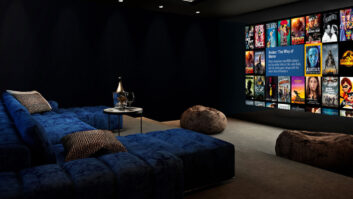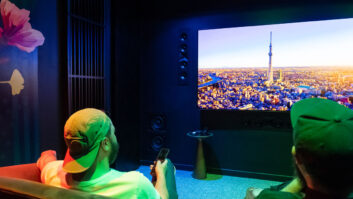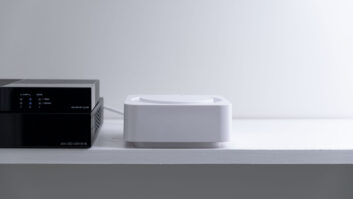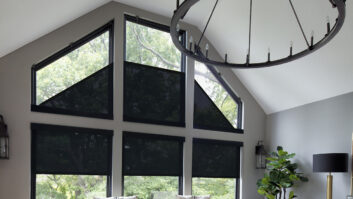What would Paris be without lights? Could theater ever have evolved without the quintessential spotlight? How about cinema? Lighting has come a long way since Thomas Edisons discovery of incandescent light nearly 130 years ago. Now an integral part of our everyday life, it is impossible to escape its significance to the development of entire industries, ours included.
Over the years, the custom installation and residential systems markets have kept focused on the audio and visual bells and whistles that most clients initially take into consideration, while lighting was left to the architect or lighting designer, or worse still, never thought of at all.
There are dealers and installers involved in homes that have lighting designers involved, but that is less than one percent, said Tom Doherty, industry veteran and principal of The Tom Doherty Group. I would even say it is less than a tenth of a percent, because Im saying less than one in a thousand homes that are over a million dollars have any real lighting design. This is a big opportunity [for us] and there is room for growth.
The benefits of a great lighting control system cannot be overstated. As more and more Americans increase the size of their living space, the need for effective control over security and atmosphere of what is essentially an environmental showpiece is not only valuable to the homeowner but to industry manufacturers and dealers as well.
We see lighting control systems becoming more commonplace as more and more people are exposed to the concept, said Jeff Ellis of Innovative Audio, a Crestron dealer. Many clients initially feel it is something that they dont really need until the benefits start to be explained in detail, particularly when youre talking about lighting control as a part of a whole-house automation/control system. They dont feel they need it until they get a good understanding of what it is and how it can simplify their life, once they get a feel for what it really is and can provide they realize they do want it after all. I cant imagine any client weve provided lighting control for would do without it in their next home.
On the manufacturers side, the increased interest in lighting control is also a win-win situation. I see more and more dealers concentrating on lighting control as being their core business because everybody has electricity, everybody has lights, and its something new thats growing, said Jeff Zemanek, Lutrons national sales manager of residential systems. Theres a huge opportunity where only a small percentage of current homes have something other than light switches on the wall. The opportunity is tremendous for it to be a category where they can make money, as opposed to their core businesses today which are more likely to be audio and video where its becoming more and more of a commodity and their gross margin of profit is being driven down.
With both clients and industry professionals finally on the same side of the lighting control fence, the spotlight is poised to swing toward creative use of the medium. In theater, lighting is used to great effect to create mood, atmosphere, ambiance, and to tell a story. Similarly, residential lighting systems can add a dramatic flare, both overblown and understated depending on a client tastes, to every room of a house. It is an artistic bent once reserved for lighting designers and architects, that manufacturers are beginning to converse with their dealers about, offering tips on how to utilize other aspects in and outside the homefurniture, fixtures, and the landscape itselfto accentuate the quality of their lighting products.
Part of a really good scene includes more than just lighting, said Clyde Wixom, Northeast and Canada regional sales manager for Vantage Controls. One of the things we end up talking about in training is the additional components that create a nice scene, whether its the fireplace or the blinds.
There are two aspects of lighting, Waxman continued. We have natural lighting when it is available. And even in an evening scene, when it is a dark sky, a good view of the mountains or the skyline can be an important part of the scene. In addition to that, the music and other components within that whole automation scene, is part of the lighting, or creating the ambiance, mood, or atmosphere of the room.
Critical to dressing any room with lighting, however, is the input of the client. Wixom recommends interacting with the homeowner to pick up key signals as to what they might want, including what their favorite room might be, a beloved piece of artwork, and even a chandelier that can become a part of the lighting narrative. Once vital aspects of the home have been demarcated for lighting control, the client and the installer can start testing out different settings until a consensus is reached.
Many clients are unfamiliar with lighting scenes and look to us to get them started, Ellis said. Most large homes have such an array of lights…that it becomes impractical to control them individually. We usually start off with a few scenes per area as well as whole-house scenes to allow the client to get a real-life feel for the flexibility as well as the convenience and sophistication a lighting control system can offer. Then we come back to add additional scenes or to fine tune the existing ones to best fit their needs.
The possibilities for lighting control systems vary from the very simple (turning off lights at a set time) to the sophisticated (having the lighting system interact with other integrated systems such as the alarm network). Doherty noted that, in his experience, people have first gone for automation of their landscape lighting based around an astronomical time clock, while integration of gates or garage doors into a welcome home lighting mode is a close second.
For home interiors, many dealers and manufacturers have recognized that clients show an appreciation for the all interior off scene, while a whole-house party or entertainment scene that includes audio/video components are also in demand along with a sleep or goodnight scene that basically puts the house to bed.
Generally, aside from creating scenes to best showcase their investment in the fixtures, architecture, art, and furniture that make up their home, we ask the client to think about repetitive tasks they perform and then look for ways to automate or simplify some of the operations they go through to perform or prepare for them, Ellis said.
Crestron, according to Ellis, is preparing to ship the CLW-DIM1RF wall box dimmer that is designed to be retrofitted into existing installations or stand as a processor in a new build. Were very excited to get this product in and run it through its paces, Ellis said. As a residential systems integrator we strive to provide our clients with control of their home as a single entity, with lighting being an integrated piece of the puzzle and not necessarily a stand-alone system.
Vantage Controls recently unveiled the InFusion Controller and InFusion Design Center software to offer flexible lighting control and the integration of existing third-party systems. Wixom has also hinted that the company will issue a new, Web-enabled processor in the first quarter of 2006.
Also tapping into the power of the Web, Lutrons GRAFIK series is operable from a Local Area Network (LAN), scalable to any size project, and interfaces with other existing systems. Most laptops are now conveniently able to talk to the lighting system and are able to create a scene, control it in real time, and observe it in the evening, said Doherty, a Lutron dealer. We find the Lutron equipment to be one of the most reliable pieces of electronics to go into a home. So we are using the Lutron processor to actually be the central control for a lot of the integration that we do.
The ability to have the lighting system behave based on the conditions and functions of other non-lighting systems and sub-systems is allowing us to provide very sophisticated control for our clients that are looking for extravagant systems and very powerful, yet simple, operation for the less fanatical client.
In the same vein, Intermatic recently unveiled its HomeSettings Pro, a Z-Wave based dimmer that provides a wireless, low-cost lighting control option. It used to be that you were only scratching the surface when you were willing to spend $50,000 to $100,000, said Jeff Bovee, marketing manager, energy control for Intermatic. We are looking to bring that down to a tenth of that cost or less. As that price seems to creep down, and it becomes available to homes that arent the million dollar or plus homes, and we get to the point of it being a $250,000 home, there is no reason why they cant have several rooms of lighting control. I think that is going to fuel the rapid expansion of the market.
Fun aspects and products of lighting scenes aside, the functionality of any system is the backbone of securing a clients happiness with a product. At the end of the day, if a client cant figure out what buttons to push to achieve a desired effect then all of that hard work on angles, filters, fabric color matching, and bulb temperatures would have been wasted.
The last aspect is the actual interface between the people that are occupying the space, the space and the light itself, Wixom said. One of the things we want to make sure that our dealers understand is that you want to be able to set the scene quickly and easily as the occupant of that space. You dont want to take more than a second or two to create that mood. You are doing a disservice if it is not intuitive, very simple, and if it is at all disruptive to the flow of the homeowner.
To achieve seamless interaction between the client and the products, dealers and manufacturers agree that there must be a collaborative effort between the installer, the client and when necessary, a lighting designer. We recommend that our dealers use a light designer, because if you are trying to be a jack of all trades you might not nail every aspect of the componentry that you want, Wixom said. Rather than trying to be the be-all solution, partner with professionals that will create the best-breed solution for your client.
As manufacturers continue to create effective, sophisticated lighting products, and dealers open their eyes to expanding possibilities within their projects, the lighting controls segment can only get bigger and better. Just like an amazing home theater system or a great audio installation, lighting is poised to become a shining star that clients will wish for.
I see more homes having lighting control as standard, Zemanek said of the future. I see awareness increasing with homeowners where they are asking for it, instead of it being sold to them. I see the homeowner realizing that you can actually spend less money on a house and have it look much, much nicer than an expensive house by creating the right lighting scenes, atmosphere, and ambiance.
Llanor Alleyne is managing editor of Residential Systems in New York City.







